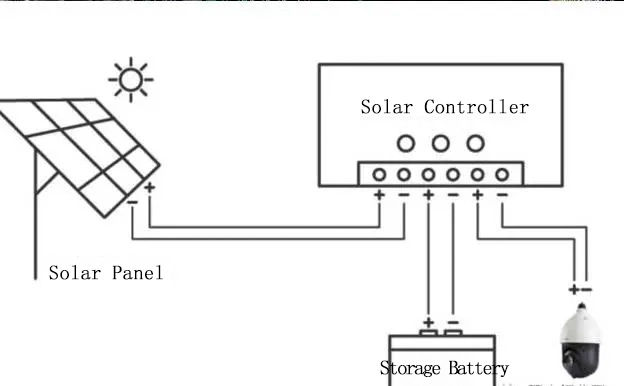The Working Principle of Solar Monitoring System
The working principle of the solar energy monitoring system is that solar panels absorb light energy and convert it into electrical energy, and then divide the electrical energy through the controller, provide it for direct use by monitoring and store it in the storage battery, and provide long-lasting power for monitoring.
Introduction of Solar Monitoring System
Table of Contents
I. Solar Power Equipment
1. Solar Panels
(1) Types
The materials of solar panels primarily include: monocrystalline silicon, polycrystalline silicon, and amorphous silicon.
- Monocrystalline Silicon Solar Panels: Photoelectric conversion efficiency is around 15%, with the highest reaching 24%. This is the highest conversion efficiency among all types of solar panels, but they are more expensive to manufacture. Their typical lifespan is about 15 years, with the maximum being around 25 years.
- Polycrystalline Silicon Solar Panels: Photoelectric conversion efficiency is around 12%, and they’re somewhat cheaper than monocrystalline silicon panels. Their lifespan is shorter than monocrystalline silicon.
- Amorphous Silicon Solar Panels: Can generate power even in weak light conditions. Internationally advanced amorphous silicon solar panels have a photoelectric conversion rate of about 10%, and this efficiency decreases over time.
(2) Parameters
- Peak Power: Refers to the power of the solar panel when sunlight is strongest, measured in watts (W).
- Working Voltage
- Dimensions: Refers to the size of the solar panel.
- Photoelectric Conversion Rate: The efficiency of the solar panel in converting sunlight into electrical energy.

2. Solar Controller
The full name is the solar charge-discharge controller. It is used in solar power generation systems to automatically control the charging of the battery by multiple solar cell arrays and the power supply of the solar inverter load by the battery. It specifies and controls the charging and discharging conditions of the battery, and controls the energy output of the solar cell modules and batteries to the load according to the power requirements of the load. It is the core control part of the entire photovoltaic power supply system.
3. Storage Battery
As the name suggests, a storage battery is used to store electricity. It primarily stores the electrical energy converted by solar panels and can be used multiple times in a cycle. In a comprehensive monitoring system, some equipment requires a 220V or 110V AC power source, while the direct output of solar power is typically 12V DC, 24V DC, or 48V DC. Therefore, to provide power to 220V AC or 110V AC devices, the system must include a DC/AC inverter to convert the direct current produced by the solar photovoltaic power system into alternating current.
- Battery Capacity: = Discharge Current × Discharge TimeMeasured in AH: For example, 50AH means it can provide a current of 50A for 1 hour.
- Voltage: Monitoring systems are generally equipped with 12 volt lithium battery.
II.The Working Principle of Solar Monitoring System
1. When the sun is strong, the controller divides the electric energy converted by the solar panel into the one used for monitoring and the one stored by the battery;
2. When the sun is weak, the controller will take out the electric energy from the battery and provide it for monitoring when the electric energy converted by the solar energy is not enough to monitor the normal use;
3. During nighttime or on cloudy days when sunlight conditions are unfavorable, the energy storage system takes over to power the video surveillance.
In addition to sparsely populated outdoors, roads, home courtyards, scenic spots and other places can also be installed with solar monitoring, as long as the solar panels are not blocked by obstructions. It should be noted that the installation of solar monitoring should pay attention to the solar panels that can fully receive the sunlight, the battery also needs to be replaced regularly, and the waterproof cover should be fixed to prevent losses caused by water ingress.

Solar Monitoring System vs Tradtional Monitoring System
- Addresses the monitoring needs of remote areas, as well as regions with no humans, electricity, or network.
- Economical, practical, and reliable.
- Low construction cost, quick installation, short construction time, good safety, and minimal maintenance costs.
- Operates normally during rainy days. Solar power doesn’t solely depend on sunlight to generate electricity; any form of light will do. The system has energy storage devices to ensure it works at night or on cloudy/rainy days.
- The equipment operates with automatic control, capable of unmanned operation and wireless remote monitoring.
- Utilizes specialized monitoring controls and inverter systems. It doesn’t interfere with regular signal transmission and reception for monitoring. Management and maintenance are simple, convenient, and operational costs are very low.
- Employs standalone solar power for wireless transmission, including 4G and WiFi, fully wireless.
- Components are flexible, compact, and easy to install and network.
- Provides both alternating current (AC) and direct current (DC) power supplies to meet various load electricity needs.
- Uses a maintenance-free waterproof lithium battery as the energy storage device, operating temperatures ranging from -40℃ to +60℃, characterized by long life and high performance.



